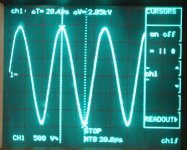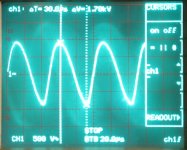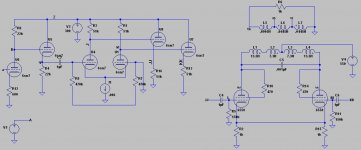I experimented with SRPP stage with GU48 & 250TH in lower part and GMI11 & GU81on the top. Cascade supply 4200V-50mA. SRPP with two GU48 didn’t give me enough gain. Best that I’ve got was with 250TH & GMI11. GMI11 isn’t the best choice of course also, Idea required some indirect heated pentode, but I just had these. There are oscillograms with 180 & 1680pF of load on 20kHz. Not too bad for first experiment.
Attachments
ESL Direct drive
I have owned a pair of Acoustat speakers for over 7 years . I've tried many different amplifiers throughout the years to drive them to bring out the best sound. Tube amplifiers deliver the best sound so far. I built a pp amp using 6550 output tubes and 6sn7 as the drivers. Using a long tail pair phase splitter with a 6SL7 triode. B+ is at 500 volts in UL mode. Using Hammond 1650R transformers. I have eliminated the step up transformers in the MK121 module and connected the stators directly to the plates of the 6550's. I reversed the diodes in the bias power supply so that the B+ from the amplifier adds to the bias voltage. The sound level is more than adequate for above normal listening levels. The measured bias voltage is at 5700 volts with the amplifier voltage added. West Marine has high voltage wire available rated at 15000 volts. This was the best modification I have done for these speakers.
I have owned a pair of Acoustat speakers for over 7 years . I've tried many different amplifiers throughout the years to drive them to bring out the best sound. Tube amplifiers deliver the best sound so far. I built a pp amp using 6550 output tubes and 6sn7 as the drivers. Using a long tail pair phase splitter with a 6SL7 triode. B+ is at 500 volts in UL mode. Using Hammond 1650R transformers. I have eliminated the step up transformers in the MK121 module and connected the stators directly to the plates of the 6550's. I reversed the diodes in the bias power supply so that the B+ from the amplifier adds to the bias voltage. The sound level is more than adequate for above normal listening levels. The measured bias voltage is at 5700 volts with the amplifier voltage added. West Marine has high voltage wire available rated at 15000 volts. This was the best modification I have done for these speakers.
Some people have has success using a tube amplifier with 32 ohm or 70 volt taps.
Starting at 70 volts RMS is better than 30.
I read an article long a go where they used a 7000 ohm CT tube amplifier transformer for the step up.
Another option is to find a an output transformer with untralinear taps and drive the 50 or 40% taps. Use push pull 572Bs at 1500volts will get you into the +- 2600, 5400 peak to peak range.
You probably want to load the secondary a little to avoid arcing.
Starting at 70 volts RMS is better than 30.
I read an article long a go where they used a 7000 ohm CT tube amplifier transformer for the step up.
Another option is to find a an output transformer with untralinear taps and drive the 50 or 40% taps. Use push pull 572Bs at 1500volts will get you into the +- 2600, 5400 peak to peak range.
You probably want to load the secondary a little to avoid arcing.
Frequency response ESL amp
Here is the frequency response from 10hz to 20khz
I used a lower level for testing the output cause it gets too loud. This response is with the speaker connected.
Freq Output Volts Plate to plate
10 107.5
20 107.5
30 101.0
40 100.0
50 100.0
60 100.0
70 100.0
80 99.5
90 100.0
100 100.0
200 99.5
300 99.5
400 100.0
500 99.5
600 100.0
700 99.5
800 99.5
900 99.5
1000 100.0
2000 100.0
3000 100.5
4000 100.0
5000 100.5
6000 101.5
7000 102.0
8000 103.0
9000 104.5
10000 105.5
11000 107.0
12000 109.0
13000 111.0
14000 113.0
15000 116.0
16000 118.0
17000 121.5
18000 124.5
19000 127.5
20000 131.0
Here is the frequency response from 10hz to 20khz
I used a lower level for testing the output cause it gets too loud. This response is with the speaker connected.
Freq Output Volts Plate to plate
10 107.5
20 107.5
30 101.0
40 100.0
50 100.0
60 100.0
70 100.0
80 99.5
90 100.0
100 100.0
200 99.5
300 99.5
400 100.0
500 99.5
600 100.0
700 99.5
800 99.5
900 99.5
1000 100.0
2000 100.0
3000 100.5
4000 100.0
5000 100.5
6000 101.5
7000 102.0
8000 103.0
9000 104.5
10000 105.5
11000 107.0
12000 109.0
13000 111.0
14000 113.0
15000 116.0
16000 118.0
17000 121.5
18000 124.5
19000 127.5
20000 131.0
......Can you give the B+ on the outputs....an 6sn7 frontend?
I Like the sound, of 6SN7 .... have a old Jolida 502 that i have re-worket with 6SN7 drivers.....just got some new old stock..RCAs......sweet sound.... the Jolidas output iron is vary good.....thats all that left of Jolida in the amp now
Thanks for the Amp Schematic
I Like the sound, of 6SN7 .... have a old Jolida 502 that i have re-worket with 6SN7 drivers.....just got some new old stock..RCAs......sweet sound.... the Jolidas output iron is vary good.....thats all that left of Jolida in the amp now
Thanks for the Amp Schematic
Bzal - very interesting - I have been thinking of doing this myself - the stator taps on your schematic - where exactly? Are they at 8 and 4? What is 16?
The 13 and 7 H inductors - have any additional info or anything special about them? Where is the Hammond tranny?
The plates ride on top of the 5kv bias?
Whole shabang looks like an amp I was already planning on building (without second 6SN7)
Sorry for all the dumb questions...just curious...
The 13 and 7 H inductors - have any additional info or anything special about them? Where is the Hammond tranny?
The plates ride on top of the 5kv bias?
Whole shabang looks like an amp I was already planning on building (without second 6SN7)
Sorry for all the dumb questions...just curious...
Last edited:
The stators are connected directly to the plates of the 6550's. I also connected a common connection from the amplifier to the ESL housing. The inductors are a representation of a Hammond transformer 1650R. I reversed the diodes on the bias supply to generate a negative bias. The voltage on the plates now adds to the bias increasing efficiency. The cathode followers used in the phase splitter help increase the high frequency response to the grids of the 6550 tubes. This was verified on an oscilloscope.
Thought about this a few years back and did contact a few of the transformer manufacturers like Sowter. Consensus was that it wouldn't work because of something to do with the large inductance affecting the frequency response somehow - don't remember the details. Also the toroidal company in Canada said they could probably do it but they just weren't interested if only 2 pieces were involved.
I have a friend in CT who powers the stators of his panels directly from the plates of his Heathkit W6's; gets plenty of sound output - AND SOUNDS GREAT. Doesn't work with the Quads as the stator spacing is too great.
Charles
Interesting about the transformer issue.
Roger West at Sound lab has for many years run 2 transformers for his panels. 1 (large) xformer for the low freq and 1 for the HF.
There is a pic of the xformers at this link:
Company manufacturing electrostatic loudspeakers
I misset that post.... 500v on the B+......
Yes i have done this with my Acoustats panels in the past........sounds vary good but not a nuf output for me!
Some of the guys with SoundLabs came up with a tranfourmer setup i am using now on my Acoustat ....lot more output.... can drive the panels with 60 wattt of tube power ..........No res on the secdary side of the bass tanfourmers .....just 1.5mf 6k caps on the hi-tranfourm sed side...
Best sound an most output i have ever got out of the Acoustats...
But these Apogee just sound better.....Tuff to beat the sound of a open driver......well to me..
Long Live Acoustats An Apogee.....
Yes i have done this with my Acoustats panels in the past........sounds vary good but not a nuf output for me!
Some of the guys with SoundLabs came up with a tranfourmer setup i am using now on my Acoustat ....lot more output.... can drive the panels with 60 wattt of tube power ..........No res on the secdary side of the bass tanfourmers .....just 1.5mf 6k caps on the hi-tranfourm sed side...
Best sound an most output i have ever got out of the Acoustats...
But these Apogee just sound better.....Tuff to beat the sound of a open driver......well to me..
Long Live Acoustats An Apogee.....
Last edited:
OK, couple questions - the Soundlab trannys - are they on separate hi and low panels, or do they "mix" together like the Acoustats?
Also, bzal, when you "ride" the plate voltage on top of the bias voltage, you are using neg bias, correct? So (ok, dumb question here) are you repelling dust as opposed to attracting dust to the panel with normal bias?
Also, bzal, when you "ride" the plate voltage on top of the bias voltage, you are using neg bias, correct? So (ok, dumb question here) are you repelling dust as opposed to attracting dust to the panel with normal bias?
John..........thay "mix" together like the Acoustats? Thay have only caps in something thay call a mixer box.....the think the caps are 1.5mf 10kV An this is my setup now in my Acoustats No REs....Just caps...Best sound ever.......well for ME
SL Panels are Just one Big Load of mass to drive!
In the pic see the black Box on the right front.
I have had the old A1s........even with the bias feed,you set till it makes a buzzzzzz....every amps i had sead NoNoNo...i wont go,
never felt as good see a pr of ESL leve my home.
like the OTLs i have thay sound Great on any speaker i have ever had...less the SLA1s............But the OTLs are tooooo....HOT for fl.
So there OUT
Long Live Acoustats An Apogee
SL Panels are Just one Big Load of mass to drive!
In the pic see the black Box on the right front.
I have had the old A1s........even with the bias feed,you set till it makes a buzzzzzz....every amps i had sead NoNoNo...i wont go,
never felt as good see a pr of ESL leve my home.
like the OTLs i have thay sound Great on any speaker i have ever had...less the SLA1s............But the OTLs are tooooo....HOT for fl.
So there OUT
Long Live Acoustats An Apogee
Attachments
Last edited:
Recently started new SET project was success to drive my Final Sound 1000i speakers. Time ago I was thinking about Direct Drive for these, but didn’t understand how properly divide signal for parts of panels.
Last mentioned question was solved with using measuring microphone assistance and I got panels connected throw the capacitor directly to the output tube plate across output and step-up transformers.
It’s work! Sound greatly improved compare with standard connection. Frequency respond become better also. I would say I never heard my speakers before
Last mentioned question was solved with using measuring microphone assistance and I got panels connected throw the capacitor directly to the output tube plate across output and step-up transformers.
It’s work! Sound greatly improved compare with standard connection. Frequency respond become better also. I would say I never heard my speakers before
- Home
- Loudspeakers
- Planars & Exotics
- Driving ESL with valves/tubes



![xover[1].jpg](/community/data/attachments/332/332242-3e31e72da8afb36ca7cd45d268856097.jpg)